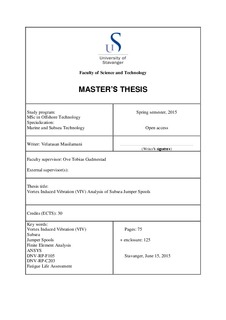| dc.description.abstract | Subsea rigid jumpers are usually rigid steel pipe sections that provide the interface between subsea structures, such as pipelines to manifolds, trees to flowlines and pipelines to risers. Each jumper shall be designed such that it is flexible enough to allow the expansion and contraction of the flowline or the pipeline due to the change in pressure rating and/or end thermal expansion and to accommodate the installation misalignment. In addition, the subsea jumper design should also be rigid enough to meet the external environmental loads.
The ability of the jumper system to accommodate these loads is achieved through its design procedure, which includes strength and fatigue analysis. The former defines the required configuration of the jumper system based on the end displacement tolerance requirements, with the least flexibility possible and the latter helps to determine the fatigue life of the system to satisfy the design life. Based on the field specific conditions and end displacement requirements, any geometry of the jumper can be used in the field architecture. The usual types of jumper configurations used in the industry are free span, M-shape, Z-shape and inverted U-shaped.
Although some designers consider these jumper systems as static elements, they are in fact susceptible to fatigue loading. This arises from the complex jumper configurations with longer unsupported lengths of the pipe section. Though the complexity is advantageous with regard to the displacement tolerance, they bring their own unique challenges from a fatigue loading perspective.
The objective of this project is to perform a sensitivity study, of the fatigue damage due to vortex induced vibration (VIV), on the typical subsea jumper system. Even though there are other modes, which can cause fatigue damage to the jumpers, like the thermal cyclic loading from flowlines, slugging effect and fluid induced vibrations, this report is confined only to the fatigue damage due to VIV. A comprehensive study of a specific case has been carried out to demonstrate the effects of VIV on a subsea jumper spool. The results are extended to general spool geometries whenever possible. The sensitivity study will assess the key parameters, like the jumper configuration, seabed current velocity and the angle of the current flow to understand the case specific severity of the fatigue damage. This analysis is performed based on the background principle followed in DNV-RP-F105 and using the finite element analysis (FEA) tool ANSYS.
Based on the observations from the sensitivity study, we understand that from the fatigue life of the typical jumper system, we can define the case specific critical length of the jumper. This critical length identification helps to understand the cases that require the use of the VIV mitigation measures. It is also observed that for the same jumper configuration under the same seabed current condition, the fatigue life would be different based on the angle of current flow and the yearly probability of occurrence of the seabed current velocity. | nb_NO |
